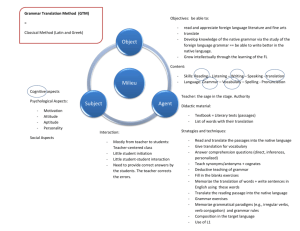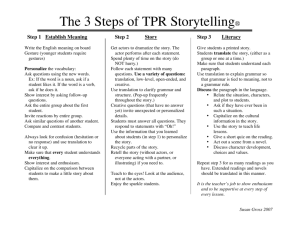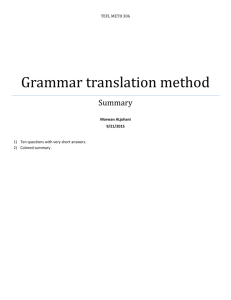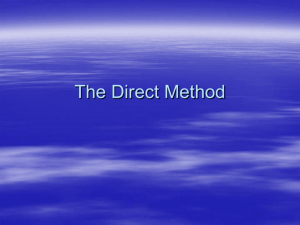Ttranslation Method - Grammar
advertisement
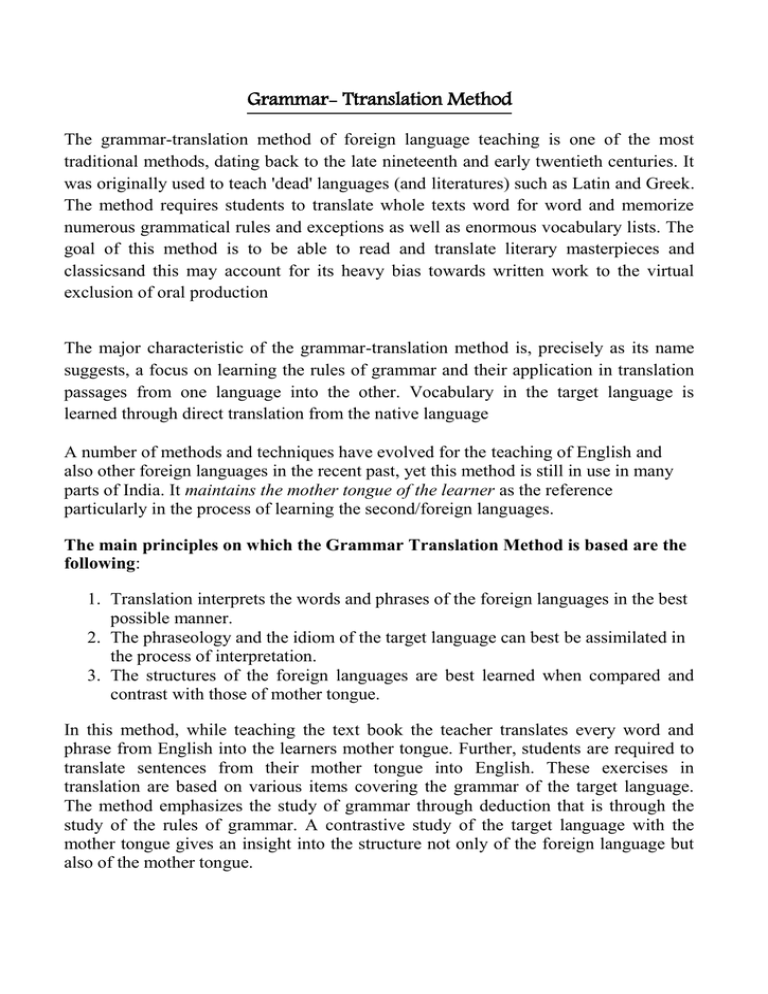
Grammar- Ttranslation Method The grammar-translation method of foreign language teaching is one of the most traditional methods, dating back to the late nineteenth and early twentieth centuries. It was originally used to teach 'dead' languages (and literatures) such as Latin and Greek. The method requires students to translate whole texts word for word and memorize numerous grammatical rules and exceptions as well as enormous vocabulary lists. The goal of this method is to be able to read and translate literary masterpieces and classicsand this may account for its heavy bias towards written work to the virtual exclusion of oral production The major characteristic of the grammar-translation method is, precisely as its name suggests, a focus on learning the rules of grammar and their application in translation passages from one language into the other. Vocabulary in the target language is learned through direct translation from the native language A number of methods and techniques have evolved for the teaching of English and also other foreign languages in the recent past, yet this method is still in use in many parts of India. It maintains the mother tongue of the learner as the reference particularly in the process of learning the second/foreign languages. The main principles on which the Grammar Translation Method is based are the following: 1. Translation interprets the words and phrases of the foreign languages in the best possible manner. 2. The phraseology and the idiom of the target language can best be assimilated in the process of interpretation. 3. The structures of the foreign languages are best learned when compared and contrast with those of mother tongue. In this method, while teaching the text book the teacher translates every word and phrase from English into the learners mother tongue. Further, students are required to translate sentences from their mother tongue into English. These exercises in translation are based on various items covering the grammar of the target language. The method emphasizes the study of grammar through deduction that is through the study of the rules of grammar. A contrastive study of the target language with the mother tongue gives an insight into the structure not only of the foreign language but also of the mother tongue. Advantages The grammar translation method has two main advantages. 1. The phraseology of the target language is quickly explained. Translation is the easiest way of explaining meanings or words and phrases from one language into another. Any other method of explaining vocabulary items in the second language is found time consuming. A lot of time is wasted if the meanings of lexical items are explained through definitions and illustrations in the second language. Further, learners acquire some sort of accuracy in understanding synonyms in the source language and the target language. 2. Teacher’s labor is saved. Since the textbooks are taught through the medium of the mother tongue, the teacher may ask comprehension questions on the text taught in the mother tongue. Pupils will not have much difficulty in responding to questions in the mother tongue. So, the teacher can easily assess whether the students have learned what he has taught them. Communication between the teacher and the learner does not cause linguistic problems. Even teachers who are not fluent in English can teach English through this method. That is perhaps the reason why this method has been practiced so widely and has survived so long. Disadvantages Along with its advantages, the grammar translation method comes with many disadvantages. 1. It is an unnatural method. The natural order of learning a language is listening, speaking, reading and writing . That is the way a child learns his mother tongue in natural surroundings; but, in the Grammar Translation Method the teaching of the second language starts with the teaching of reading. Thus, the learning process is reversed. This poses problems . 2. Speech is neglected. The Grammar Translation Method lays emphasis on reading and writing. It neglects speech. Thus, the students who are taught English through this method fail to express themselves adequately in spoken English. Even at the undergraduate stage they feel shy of communicating using English. It has been observed that in a class[, which is taught English through this method, learners listen to the mother tongue more than that to the second/foreign language. Since language learning involves habit formation such students fail to acquire a habit of speaking English. Therefore, they have to pay a heavy price for being taught through this method. 3. Exact translation is not possible. Translation is, indeed, a difficult task and exact translation from one language to another is not always possible. A language is the result of various customs, traditions, and modes of behavior of a speech community and these traditions differ from community to community. There are several lexical items in one language, which have no synonyms/equivalents in another language. For example, the meaning of the English word ‘table’ does not fit in such expressions as 'table of contents’, ‘table of figures’, ‘multiplication table’, ‘time table’ and ‘table the resolution’, etc. English prepositions are also difficult to translate. Consider sentences such as ‘We see with our eyes’, ‘Bombay is far from Delhi’, ‘He died of cholera’, 'He succeeded through hard work’. In these sentences ‘with’, ‘from’, ‘of’, and ‘through’ can be translated into the Hindi preposition ‘se’ and vice versa. Each language has its own structure, idiom and usage, which do not have their exact counterparts in another language. Thus, translation should be considered an index of one’s proficiency in a language. 4. It does not give pattern practice. A person can learn a language only when he internalizes its patterns to the extent that they form his habit. But the Grammar Translation Method does not provide any such practice to the learner of a language. It rather attempts to teach language through rules and not by use. Researchers in linguistics have proved that to speak any language, whether native or foreign, entirely by rule is quite impossible. Language learning means acquiring certain skills, which can be learned through practice and not by just memorizing rules. The persons who have learned a foreign or second language through this method find it difficult to give up the habit of first thinking in their mother tongue and then translating their ideas into the second language. They, therefore, fail to get proficiency in the second language approximating that in the first language. The method, therefore, suffers from certain weaknesses for which there is no remedy. Key features of the Grammar Translation Method : 1) Classes are taught in the mother tongue, with little active use of the target language. 2) Much vocabulary is taught in the form of lists of isolated words. 3) Long elaborate explanations of the intricacies of grammar are given. 4) Grammar provides the rules for putting words together, and instruction often focuses on the form and inflection of words. 5) Reading of difficult classical texts is begun early. 6) Little attention is paid to the content of texts, which are treated as exercises in grammatical analysis. 7) Often the only drills are exercises in translating disconnected sentences from the target language into the mother tongue. 8) Little or no attention is given to pronunciation. Typical Techniques Diane Larsen-Freeman, in her book Techniques and Principles in Language Teaching (1986:13) provides expanded descriptions of some common/typical techniques closely associated with the Grammar Translation Method. The listing here is in summary form only. 1) Translation of a Literary Passage : (Translating target language to native language) 2) Reading Comprehension Questions (Finding information in a passage, making inferences and relating to personal experience) 3) Antonyms/Synonyms (Finding antonyms and synonyms for words or sets of words). 4) Cognates (Learning spelling/sound patterns that correspond between L1 and the target language) 5) Deductive Application of Rule (Understanding grammar rules and their exceptions, then applying them to new examples) 6) Fill-in-the-blanks (Filling in gaps in sentences with new words or items of a particular grammar type). 7) Memorization (Memorizing vocabulary lists, grammatical rules and grammatical paradigms) 8) Use Words in Sentences (Students create sentences to illustrate they know the meaning and use of new words) 9) Composition (Students write about a topic using the target language) Disadvantages The Grammar Translation Method may make the language learning experience uninspiring and boring. The Grammar Translation Method may also left the students with a sense of frustration when they travel to countries where the studied language is used (they can’t understand what people say and have to struggle mightily to express themselves at the most basic level) This method neither approaches nor encourages the students’ communicative competence.



